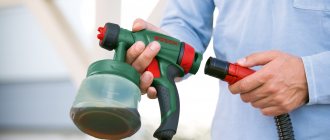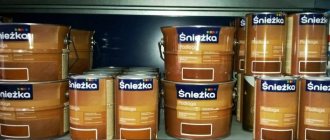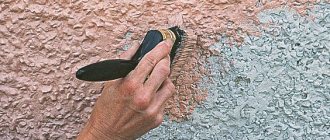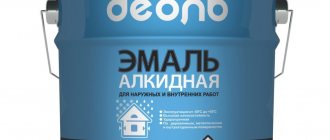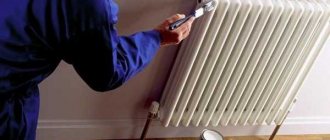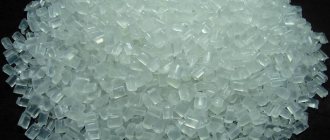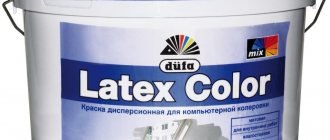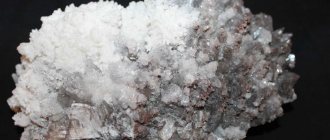Before you start painting your house, shed, garage or fence, you need to choose the right paint. It's not that simple: some types are better suited for exterior walls, others for interior walls, and others cope well with moisture and are suitable for a bathroom or basement. When buying material, it is useful to first find out how acrylic paint differs from alkyd paint, whether they can be mixed, and also which one is better to take.
Source regstroy23.ru
What is acrylic paint
Before you figure out what the difference is between alkyd and acrylic paints, it’s worth learning more about them.
Acrylic paint is used in construction and repair work, as well as in painting. It consists of acrylic, which is obtained by splitting acrylic acid. The process uses an aqueous mixture of ethanol or chloroform. The result is a transparent synthetic substance that has excellent technical characteristics. Color is achieved through pigments: inorganic, organic (the colors are bright, but fade quickly), synthetic or natural.
The advantages of acrylic paints include:
- Persistence. Dried acrylic cannot be washed off with anything; you can only sand it off or scrape it off, and the result will most likely be unsatisfactory.
- Durability and wear resistance. On average, acrylic “lives” 10-12 years without any changes.
- Acrylic paint is easy to apply, strokes are not deformed. No additional fastening is required.
- You can achieve almost any effect by choosing the appropriate type. For example, acrylic “like watercolor” will help create blurry strokes.
Source kraski-net.ru
- Another difference between alkyd paint and acrylic paint is that acrylic does not fade in the sun and does not fade over time. Having painted your floors with acrylic, you can safely wash them without fear that the paint will rub off.
- Acrylic has low consumption, since the paint can be diluted with water without harming the texture.
Paint is available in different volumes and containers (tubes, ink, cans), which allows you to choose the right option. It is worth noting that when acrylic dries, it often turns out darker than the example on the packaging.
The disadvantages of acrylic paint include the following features:
- Acrylic dries quickly. This can be a problem for beginners, since they will not have time to correct the mistake. In addition, you should not leave a brush or roller stained with paint for a long time - after drying, you will have to throw it away.
- Acrylic does not tolerate sub-zero temperatures; it immediately loses its properties.
- The paint is not resistant to solvents.
Acrylic is used everywhere: during construction and renovation, for external and internal work. They are used to paint wood, concrete, ceramics, glass, metal, brick, drywall, and wallpaper.
Source industriebedarf24-shop.de
Advantages and disadvantages
The main advantages of alkyd-based paints include:
- quick drying;
- resistance to moisture and chemicals;
- ease of work;
- low price;
- impressive selection of shades.
Initial polymerization occurs within an hour, and maximum hardening is achieved within several days. No professional working equipment is required to perform painting. Among the problematic aspects, it is worth highlighting the not very long durability of the coating - with intensive use and exposure to ultraviolet radiation, it can turn yellow after just a few years. In addition, as the components evaporate, they emit a specific odor, which is why it is not recommended to stay in a freshly painted room without ventilation.
The acrylic group retains its excellent strength and aesthetic characteristics even at elevated temperatures, making it suitable for painting radiators and similar heating structures. Due to its high adhesion, it lasts up to eight years on wooden products, and up to ten on plastered and metal products. Among the additional advantages:
- resistance to UV rays, which is important for exterior finishing of buildings;
- transparency, allowing the use of paint for light wood species;
- good hiding power at low consumption;
- providing natural ventilation.
They dry from half an hour to two hours (drying time depends on the ingredients of a particular solution and the state of the environment), although it takes quite a long time to gain final strength. With appropriate additives, they provide excellent protection against corrosive processes and are even suitable for rust. Random strokes can be easily removed without deforming the rest of the area. Among the disadvantages are the relatively high cost and the use of solvents.
What is alkyd paint
You can clearly see the differences between alkyd and acrylic paints now. Alkyd paint is produced on the basis of an organic solvent (usually industrial kerosene). The composition also includes alkyd varnish, fillers (fine marble and granite chips, sand, oils), color pigments, solvents (white spirit or turpentine).
The advantages of alkyd paints include the following:
- Increased resistance and durability.
- Elasticity and no shrinkage. After drying, the paint will not crack.
- Protection of the painted surface.
- Good resistance to temperature changes: alkyd paint can withstand from -50 to +50 degrees.
- Resistance to natural influences.
- Economical and easy to apply. Due to its brightness, the paint can be applied in one layer.
- Fast drying.
- High adhesive properties when applied to any surface.
- The ability to use it indoors and outdoors, on various surfaces: wood, metal, brick, concrete, drywall and others.
Source odstroy.ru
Like alkyd paints, alkyd paints have a wide color spectrum, but it is still wider, and the shades offered are brighter. In addition, alkyd compounds are cheaper. Depending on the surface, the compositions have additional additives. For example, alkyd compositions for wood include antiseptics, and for metal - anti-corrosion substances.
Disadvantages include:
- High toxicity and pungent odor of varnish. It is recommended to use the paint outside or in a well-ventilated area. It is worth noting that paint is harmful only during the application process. When it dries, the smell disappears.
- High fire hazard. Contains solvents that are easily flammable.
- Low vapor permeability and poor resistance to alkalis.
Some types of alkyd paints may fade or yellow.
Details about acrylic paint and its uses
First of all, let's consider the positive properties of acrylic paints and enamels:
- Preservation of original properties even at high temperatures. Thanks to this, the material can be used for radiators and radiators of heating systems;
- Long service life. Used wood paint can be used for up to 10 years, and for metal and plastered surfaces - up to 20 years;
- It is UV resistant and therefore suitable for outdoor use;
- Corrosion protection, allowing you to paint the surface of already existing rust;
- The good thing is that you can use acrylic paint without worrying about the release of harmful substances and unpleasant odors.
But it is also worth considering the disadvantages:
- High cost compared to alkyd paints;
- Long drying period;
- Difficulties in obtaining the correct and high-quality composition of the material.
To properly use high-quality acrylic paints, the following rules must be observed:
- Remove the old coating and clean the surface very thoroughly with sandpaper;
- Apply special primer to prevent rotting;
- Add the required amount of water to the paint and mix thoroughly;
- Apply the mixture to the surface using special brushes and rollers.
Before painting in acrylic red, the surface must be very well cleaned of dust and other impurities and no less well dried.
What is the difference between paints
Due to similar names, alkyd and acrylic paints are often confused or considered varieties of the same thing. But this is a big mistake: the colors are very different from each other.
Source ad-cd.net
Let's look at the difference between alkyd paint and acrylic paint. The main difference lies in their compositions. Alkyd paint is very similar to oil paint in terms of the hardening mechanism and the formation of a film on the surface. This film is slightly stronger than similar oil formulations, but is less elastic. The composition also includes polyhydric alcohols, which are produced from orthophthalic acid and glycerin. Acrylic paints are made from acrylic or plexiglass. Thanks to the use of water as a solvent, the composition does not have a strong odor.
The paints also differ in their properties:
- The durability of acrylic paint is higher than alkyd: it is recommended to renew the former every 5-20 years (depending on the surface material and its preparation), the latter every year (the top layer is severely damaged by the sun and oxygen).
- Acrylic practically does not change under the influence of ultraviolet radiation, does not fade or turn yellow. It is better to protect alkyd paints from the sun.
- The palette of alkyd compositions is wider than that of acrylic, and the colors are brighter. At the same time, acrylic fades worse.
Source carboplast.bg
- Acrylic mixtures are more resistant to mechanical damage (scratches and deformations) than alkyd ones.
- Alkyd or acrylic paints also differ in drying speed. Acrylic dries in 2 days, but gains full strength in 30 days. Alkyd paint lasts 1-2 days.
- Acrylic has no pungent odor and is non-toxic. It is better to apply alkyd compounds in a well-ventilated area using protective equipment.
- The price of acrylic is higher.
Thus, it is impossible to decide unambiguously which paint is better. It is necessary to choose depending on the situation, application site, material and other characteristics.
Comparison by main properties
These paint and varnish products differ from each other not only in their composition or characteristics, but also in their basic properties. When comparing their properties, first of all you need to highlight:
- Duration of service life. Acrylic enamels are able to retain their original appearance longer. It is recommended to renew alkyd paints at least once a year, but acrylic paints, subject to all technologies for preparing the surface to be painted before application, can last from 8 (when painting a wooden surface) to 20 (when painting a plastered surface) years.
- Indicators of resistance to ultraviolet radiation. Acrylic enamel is more resistant to ultraviolet radiation. When exposed to the sun, it does not acquire a matte tint, does not turn yellow and does not fade.
- Drying time. Alkyd enamel dries much faster. The period of its final drying is about 2 days. The curing period for acrylic film is 30 days.
Comparing the basic properties of paints, it should be noted that acrylic paints, despite the longer drying time, are more resistant to mechanical stress. However, alkyd paints and varnishes are represented by a large range of different shades and tones, thanks to which they can be used when performing a variety of decorative work indoors.
Is it possible to mix paints?
Mixing paints or applying them to each other is not recommended. Due to the strong difference in composition, it is impossible to predict how they will behave. If you apply a layer of acrylic to an alkyd layer, the latter may appear in dark spots. If you apply alkyd paint to acrylic paint, it may not stick.
The only option to combine the compositions is to apply paint to the old layer, previously primed with a suitable composition (under acrylic you need to use an acrylic primer).
The video explains the difference between acrylic and alkyd paints.
Application of enamels for cars
Now think about what enamel to apply to cars: alkyd or acrylic? And what is the difference between acrylic paint and alkyd paint?
Acrylic material deserves its place of excellence in this area. This is due to the fact that the instrument has good reflective properties and resistance to mechanical loads. In addition, the tool used dries quickly and at the same time reduces shrinkage.
Alkyd enamel for cars is not the best because it has a long drying time and at the same time does not provide such a uniform shine as an acrylic coating. The disadvantages of such enamel are compensated by low costs. You can also apply one coat of alkyd, while acrylic automotive enamel requires gradual painting in thin layers, each of which must dry well.
Briefly about the main thing
The building materials market is constantly expanding, new materials and compositions are appearing. They can be difficult to understand. For example, not long ago I had difficulty choosing paint. The easiest way is to buy based only on the color or material for which they are suitable. But this is unprofessional and unprofitable: if the paint is chosen incorrectly, it will have to be constantly updated.
When I needed to paint the floor on the veranda, I chose between acrylic and alkyd paint. In the end, I settled on acrylic, although the alkyd colors were more interesting and the price was more attractive. But acrylic tolerates constant washing well and lasts longer.
Question
Write in the comments, did you know the difference between acrylic and alkyd paints? Which one would you choose if you were me?
About the composition
Acrylic paint consists mainly of acrylic, which due to its chemical properties is called a polymer emulsion. Color pigments are added to give color to a substance. The main difference between enamel is the absence of a strong odor characteristic of other substances, which is associated with the use of water as a solvent. Also included are special additives that affect the material’s resistance to temperature changes and improve its viscosity.
Alkyd paint consists largely of alkyd varnish, dyes and a kerosene-based solvent. Some paints contain fire, antifungal and antiseptic additives. Therefore, such enamels are often used in joinery.
What is the difference between alkyd and acrylic paint: comparative analysis of characteristics
Acrylic enamel for floor
Same level of properties:
- water resistance;
- resistance to solvents, acids and alkalis;
- heat resistance;
- hardness;
- Application of paint by brush, pneumatic and airless spray.
Properties in which alkyd binders are superior to acrylic ones:
- wear resistance;
- applying paint with a roller;
- time to fully gain strength.
Properties in which acrylic binders are superior to alkyd ones:
- transparency and colorlessness;
- gloss durability;
- weather resistance (light fastness, resistance to ultraviolet radiation and temperature changes);
- resistance to water vapor, diluted acids and alkalis;
- elasticity, resistance to impact and bending;
- durability, resistance to aging;
- environmental friendliness;
- good grinding and polishing ability.
It should be borne in mind that the evaluation characteristics are general in nature, so in some cases the properties may not correspond to the given data, for example, acrylic floor varnish has very good wear resistance.
Paint compatibility
Acrylic paints are not recommended for use on alkyd coatings because the paint result cannot be predicted in this case. After painting, the surface can be either of good quality or of poor quality (if swelling occurs). Alkyd paints and enamels used on acrylic surfaces are in most cases removable.
Note: if acrylic paint is applied to an alkyd coating, its service life is reduced by at least 2 times.
If you still need to apply acrylic paint to an alkyd finish, you will need to prepare the surface. The product must first be thoroughly cleaned with fine-grit sandpaper and then treated with a primer. Preparatory measures will improve the adhesion of materials and reduce the likelihood of paint peeling.
Alkyd acrylic compositions are used for painting vehicles. However, their cost is high, and such paints are not used in the construction industry.
In general, acrylic paint is the best choice. However, if the budget is limited or the durability of the coating is not critical, you may want to stop choosing alkyd paint.
Alkyd or acrylic paint: what to choose? Often in everyday life we are talking about adding newness to all household items. Painting is the dominant solution to this problem. Painting various surfaces can not only add beauty, but also protect against adverse weather conditions or mechanical influences. Currently, there is a huge amount of paint and varnish materials that can satisfy the most demanding tastes of customers. Among them, two types of paint have significant weight: alkyd and acrylic. Naturally, the question arises: what is better for painting?
Properties and scope of application
The main difference between alkyd and acrylic paints is the natural origin of the first and the synthetic origin of the second. Alkyds are quite universal and can be applied to:
- metal;
- wood;
- stone.
They create a harder, but less elastic film compared to colored oil counterparts. They are rarely used for painting, but due to their neutrality to household chemicals, they are often used indoors when it is necessary to obtain a shiny, durable surface with a rich, expressive color.
Acrylic paints tend to be less bright and have a muted matte effect. They are offered on the market in a huge range of solutions and are suitable for both artistic solutions and construction and finishing work, including rust. Demonstrating low vulnerability to atmospheric influences, they are suitable for facade work.
Compatibility
Knowing the differences between alkyd paint and acrylic paint, you should also learn about the compatibility of these two paints. Many people are interested in the question of whether it is possible to apply a layer of alkyd paint on top of acrylic paint.
It must be said that the compatibility of the two products is not very good. This is due to the composition of the materials. If you combine them, there is a risk of surface swelling. If you apply acrylic to alkyd, the result will not be good - the coating will begin to delaminate. But if there is a serious need to combine these different products, then you need to clean the surfaces as much as possible, then carefully sand them and apply primer. This will help improve adhesion and reduce the risk of peeling, but the service life is reduced by about half.
How does alkyd paint differ from acrylic paint and which is better?
With all the variety of paints and varnishes, we mainly have to deal with the two most common bases for paints and varnishes - alkyd and acrylic. Let's try to figure out what the difference is and what you need to know before going to the store. Alkyd paints and varnishes have long occupied a leading position, while acrylics were developed much later, but are becoming increasingly widespread.
Alkyd and acrylic enamel: difference in composition
Alkyd film formers are low molecular weight polymers obtained from a mixture of alcohols and polybasic acids by polycondensation in the presence of fatty acids. Easily modified. Protective films are formed as a result of a chemical reaction - oxidation with atmospheric oxygen. Organic compounds are used as solvents.
Polyacrylates are high-molecular polymers obtained by the polymerization of methacrylic and acrylic acids and their derivatives. Films are formed mainly without a chemical reaction. The use of various auxiliary monomers can significantly change the characteristics of materials. The range of polyacrylates produced is very wide, ranging from hard plastics (plexiglass) to soft elastomers (artificial rubbers). They can be dissolved by both organic compounds and water. They have proven themselves to be excellent as the basis for water-dispersion paints.
